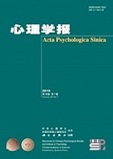|
|
Effects of Verb’s Trait of Continuance and Adverb of Instantaneous Time about Representation of Events of Temporal Shifts in Chinese Text Readin
TONG Yu-Guang,ZHANG Qi,ZHANG Li-Fang
2010, 42 (06):
663-671.
Situation model is the deep representation of events described formed by readers in text reading. How the temporal shifts of story are represented is an important dimension and a controversial issue. Scenario model considered that the units of time representation were the separated chunk (Anderson, Garrod, & Sanford, 1983); strong iconicity assumption reckoned that readers relied on sequence and continuity to process time information(Zwaan,1996) and in his experiments instantaneous temporal shifts and short temporal shifts were confused. Kelter, Kaup & Claus (2004) argued that obvious temporal discontinuity produced temporal shifts. But compared Zwaan’s experiments with examples presented by Kelter et al, the trait of verb’s continuance for temporal shifts was not clear. Thus it seemed that representing temporal shifts was not only determined by temporal adverbs, but also determined by the verb’s trait of continuance of front event. Besides, in Chinese text reading, the adverb of instantaneous temporal shifts could function as a cue followed by different temporal intervals. Hence the present study is to explore the effect of verb’s trait of continuance and adverb of instantaneous time about representation of the events including temporal shifts in text reading.
A total of 152 college students participated in present study. Using moving window and probe- judgment technique of on line reading, two experiments were carried out by using E - Prime software. Subjects tried to be self-paced for reading. When one sentence was read, they pressed the space bar, and the next sentence emerged with the former sentence’s disappearance. After several sentences were read, the emergence of "××××?" (×××× represented probe word) prompted subjects to press “J” or “F” to judge whether probe word ever emerged in text. After finishing one text, the emergence of "******" prompted subjects to answer a comprehensive question about the text. The reaction time of probe materials(the ninth sentences in experiment 1 and the probe words in the end of the eighth sentences in experiment 2) were recorded and analyzed with repeated measures of MANOVA.
The results of experiment 1 indicated that when the verb’s trait of front event was continuity, reading time was not significant differences between the sentences of instantaneous temporal shifts and the sentences of short temporal shifts. When the verb’s trait of front event was temporariness, the sentences of short shifts were read more slowly than the sentence of instantaneous temporal shifts. In experiment 2, when there was no existence of the adverb of instantaneous time, the probe words in the condition of long temporal shifts were reacted more slowly than that in the condition of short temporal shifts. But when the adverbs of instantaneous time functioned as a cue followed by temporal shifts, the reaction time of probe words in the condition of short temporal shifts was not salient than that in the condition of long temporal shifts.
The conclusions are derived from this study: (1) the verb’s trait of continuance together with the condition of temporal shifts determines the probe sentences’ reading time. It seems that, the verb’s trait of temporariness of the front event combined with the condition of short temporal shifts slows down the reading speed of sentences of short temporal shifts. The results show that, to differentiate instantaneous temporal shifts from short temporal shifts, and to differentiate the verb of continuity from the verb of temporariness are meaningful for representing the events of temporal shifts. (2) In Chinese text reading, the adverb of instantaneous time functions as a cue for representation of the events of long temporal shifts. In short, representation of events of temporal shifts is not only determined by the length of temporal interval, but also by the “time of mental temporal shifts”. "Time of mental temporal shifts" is the subjective time interval formed by readers in the process of processing temporal shifts according to their understanding of relations of events before and after temporal shifts. The verb’s trait of continuance and the adverb of instantaneous time are the important factors in influencing the "time of mental temporal shifts".
Related Articles |
Metrics
|




